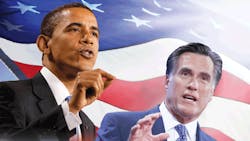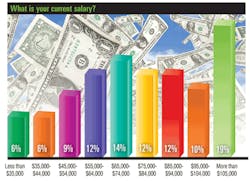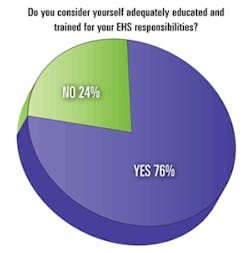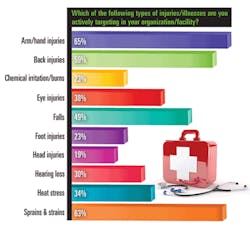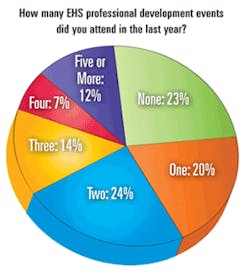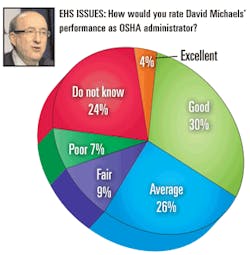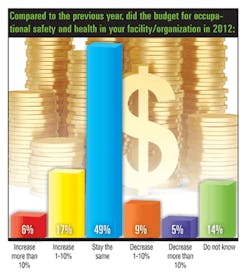A recurring theme among some of the 2012 National Safety Survey responses could be condensed into a simple message: Politics and safety don’t mix. Nearly 1,000 EHS professionals, CEOs, HR professionals, risk managers, industrial hygienists, ergonomics and consultants shared their thoughts on the upcoming presidential election, OSHA, their personal safety challenges and achievements, safety culture and more in the 2012 National Safety Survey.
Questions surrounding the presidential election drew responses from both sides of the political spectrum, with many survey participants expressing frustration over the impact the election and politics could have on occupational health and safety.
“As much as I would like to say that politics does not have a place in safety, it unfortunately does,” says Sandi J. Potts, BSSE, BOSH, COSM, CIHM, CECM, area environmental health and safety manager for PSC Industrial Services. “I have been a safety professional for over 16 years and I have never once felt that [being] Democrat or Republican should play any role in whether an employee went home safe. And unless the public starts to vote for OSHA administrator, it [shouldn’t] play any role in the position.”
Or, as this respondent put it: “I think there are too many cooks in the kitchen as it is.”
Many respondents broke down how they viewed the separate Democratic and Republican administration approaches to safety. “A Democratic administration typically runs the agency more aggressively, a Republican administration typically runs it to be more of a hands-off agency,” said one EHS leader. This respondent was more succinct: “The Democrats will do little. The Republicans will do less.”
“Generally, Democratic administrations tend to favor enforcement while Republican administrations tend to favor cooperative programs,” said another. “My personal hope is that whatever political appointees come into the picture after the election recognize that a balanced combination of enforcement and cooperation, as written into OSHA’s mission, are necessary for them to operate effectively in the future.”
Robert Flammini, site safety supervisor at Acuren Inspection Inc., would like to see consistency in OSHA and the nation’s safety culture no matter who is president. He points out that the Clinton administration approached occupational safety in one way, the Bush administration in another and President Barack Obama in yet another. “As a country, if we can establish some sort of consistency with safety and can embrace it,” we’d all be better off and safety would improve, he says.
Other respondents expressed doubt that the results of the presidential election would have any effect on occupational safety in the United States at all: “In my experience, it largely has minimal effect. The OSHA administrator may change and rules get sped up or slowed down, but on the field level, the changes are largely transparent,” one EHS leader wrote.
Still others were concerned that the political debate surrounding OSHA and safety is harmful. “The election process will hurt workplace safety improvement efforts,” a respondent commented. “The current political discourse hinders our ability to improve safety performance, as it hinders our ability to benefit as much as we should in any public policy arena. The parties (particularly the Republicans) need to recognize that dogmatic competition does not yield the best results for the country. We need to restore civil discourse if we are to remain competitive in a global environment.”
Potts stresses that if politicians are going to be involved in safety, they should be part of the solution, not the problem. She used the aftermath of Hurricane Katrina as an example of how politics negatively can impact safety: “When the politicians became involved [post-Katrina], it didn’t become any better. It became about finger pointing and not solutions.”
“Workplace safety should not be political football,” another wrote. “That is a major problem with government involvement in EHS.”
THE OSHA ENFORCEMENT DEBATE
You have been tasked to lead OSHA and have the ability to make any changes to the agency or its standards that you choose. What’s your first move?
When we posed that question to this year’s National Safety Survey respondents, almost everyone had an opinion – or the occasional political jab. When asked how he would lead OSHA, this respondent quipped, “Do you mean what would I plan before the lobbyists and their congressmen derail it? The I2P2 [Injury and Illness Prevention Program] is a good place to start. It focuses on prevention, and that’s much easier (and cheaper) to do than cleanup.”
In addition to I2P2, many respondents wanted to see clearer, more intuitive OSHA regulations.Respondent s were divided on whether OSHA needed to ramp up or tone down its enforcement. Those in support of additional enforcement wrote comments including: “Get them law enforcement authority!!! Get guns, badges and arrest authority in the investigators. The right to refuse work! The right to be involved! The right to be informed!” “Cut down on the bureaucracy and simply get into the owner’s pockets or put them in jail.” “Put some teeth in the agency, it is seen as a paper tiger. No one fears OSHA or an inspection unless someone dies.”
Others felt OSHA’s enforcement capabilities must be taken down a notch: “Change the tone,” one EHS leader suggested. “Have site auditors that are concerned with personnel’s safety and not just concerned about ‘getting’ somebody,” another wrote. Other comments included: “Become a partner in safety, not a profit center;” “less bureaucracy, more accountability;” “Make it less punitive and easier to access the information. It seems very little within OSHA seems to be friendly;” and even the request to “dissolve OSHA.”
Despite that mixed bag of opinions, the majority of respondents rated Dr. David Michaels’ performance as OSHA administrator as good (30 percent) or average (24 percent), results nearly identical to last year’s findings (31 percent and 26 percent, respectively). Seven percent ranked his performance as “poor.” (See chart on page 42 for full results.)
OSHA also received top ranking, at 31 percent, when participants were asked which agency – of OSHA, MSHA, the U.S. Chemical Safety Board, EPA and NIOSH – was most effective in meeting its statutory responsibility. NIOSH received 25 percent of participants’ votes, followed by CSB and EPA, which tied at 18 percent. MSHA trailed at 7 percent.
WHAT'S THE BIG IDEA?
EHS leaders were quick to offer suggestions to help improve OSHA. Potts would like to see a stronger OSHA presence at the state level and more consistency in federal and state programs. She also suggests that a portion of OSHA fines could be applied back to businesses as safety training grants. This would help raise training quality and safety awareness, encourage businesses to become more cooperative and compliant, and save employers money in the long run.
“I definitely think you increase productivity, longevity, safety morale of employees and reduce costs” when safety training is improved, she says. “There’s no way it can’t increase the bottom line.”
Flammini, meanwhile, suggests that in addition to penalizing companies with violations, top safety performers should be rewarded.
“I’d like to see more money not only in enforcement, but in rewarding companies that are doing well. There’s really no reward for a history of safe work practices,” he says. “Discipline employers when they do wrong and reward them when they do right.”
Additionally, Flammini thought the nation’s safety could benefit from media outreach. For example, a government-funded TV campaign revolving around workplace safety – think along the lines of Smokey the Bear and forest fire prevention – could give occupational safety a big boost, and may even trickle down into homes and communities.
“Getting that to the forefront of people’s minds will encourage them to ask questions at work,” he explains. “There’s a lot of good that can come from planting those types of seeds.”
ALPHABET SOUP: VPP AND I2P2
Ever since a 2009 GAO report identified weaknesses in OSHA’s Voluntary Protection Programs (VPP) oversight, questions have surrounded the program, including its future and its funding. Anthony Stoner, EH&S manager for Integrity Doors and Windows, a VPP Star Site, stresses that “regardless of what happens with VPP, that’s the way we’re going to operate.”
Stoner explains that his workplace has been an OSHA Voluntary Protection Programs (VPP) Star Site for the last 8 years. Achieving VPP status has resulted in significant injury reductions and a workplace culture where employees are “constantly on the lookout for ways to make improvements.” The worksite now logs hundreds of safety observations throughout the year instead of only one or two a month.“I recognize that OSHA started with an enforcement approach. That was the original mission,” Stoner says. “But VPP is another tool in their toolbox. There are companies that want to do the right things and want to excel. VPP is an excellent model of how to do that.”
Stoner also supports the proposed Injury and Illness Prevention Program (I2P2), which would compel employers to “find and fix” hazards in the workplace.
“I believe that I2P2 can be a good program, if implemented correctly,” he says. “As a VPP site, having performancebased criteria to work toward has made tremendous improvements in our programs while allowing us the flexibility to make our programs work for our site.”
“The big challenge,” he acknowledges, “is that some companies simply don’t have the resources to implement those things. You’ll always have companies that choose not to. The real challenge is reaching those companies who want to do this, but just don’t understand how. Not everyone has the resources to hire a safety professional to come in and run their programs.”
Survey respondents’ viewpoints surrounding OSHA’s proposed I2P2 program were divided between support and concern for how the standard would be implemented or enforced.
“As with most such programs, companies with safety as a core value are already there,” a respondent said. “Those without it are not. The [I2P2] regulation would likely be designed to the lowest common denominator, making it an administrative exercise for the rest of us.”
“I think that this type of legislation woSome respondents pointed out that their companies already find and fix hazards in this way. A respondent from California – a state that has had its own injury and illness prevention standard since 1991 – expressed support for a federal standard: “I would like the I2P2 to be a very robust regulation. I am currently employed in California and my employer must comply with the IIPP standard. California already does this, so why not everyone else?”
A LITTLE HELP
In recent years, EHS professionals have faced a myriad of challenges, including shrinking work forces and budgets. This year, the news wasn’t all bad – about half (49 percent) reported steady safety budgets compared to last year, while 23 percent enjoyed an increase. Fourteen percent of participants, however, faced budget decreases. (See chart on page 42 for details.)
But it’s not all about money: While more than half (56 percent) of respondents said safety ranked on par with production at their workplaces, 33 percent claimed it did not. Clearly, some participants felt their workplaces could use some help in the safety arena.
When asked to name something that could help improve their safety performance, EHS professionals offered a varied list topped by training, additional staff and improved management support and involvement.
One EHS leader stressed “the need to communicate the profitability of EHS,” while another wanted to make off-the-job safety more interactive with employees’ families. “When the employees take safety home, then a true safety culture exists,” he wrote. Another EHS leader hoped to dismantle the “us vs. them” rivalry between employees and management.
Other survey respondents said the following actions or items would be helpful to their safety programs: employee accountability and buy-in, improved communication, online management software, incentives, better workers’ compensation loss run data, additional safety equipment and, simply, more time.
The bottom line is that the EHS leaders who responded to the survey were concerned with keeping their employees safe and encouraging a strong safety culture where workers are accountable for their own safety.
“I don’t think any of us think that today is going to be the day when our stupidity or our risk-taking is going to get us hurt,” Flammini says. “In the fallout that comes after it, you’re full of regrets, but up until that point, you’re willing to take the risk. That’s the human element we all have to battle.”
According to many survey respondents, those efforts are in effect at their workplaces regardless of who leads OSHA or who sits in the Oval Office.
“I think most companies try to do the right things to the best of their abilities,” Stoner says.“I would like to see safety step out of the political arena in general. OSHA’s function, in my opinion, is to promote workplace health and safety through all the resources they have available to them. It shouldn’t be something where politics negatively impact anyone’s ability to improve health and safety in the workplace.”
Or, as one safety professional commented in the survey: “Whether the president or OSHA director changes or stays the same, we will continue to do the same excellent job because it is the right thing to do.”
About the Author

Laura Walter
Laura Walter was formerly senior editor of EHS Today. She is a subject matter expert in EHS compliance and government issues and has covered a variety of topics relating to occupational safety and health. Her writing has earned awards from the American Society of Business Publication Editors (ASBPE), the Trade Association Business Publications International (TABPI) and APEX Awards for Publication Excellence. Her debut novel, Body of Stars (Dutton) was published in 2021.
